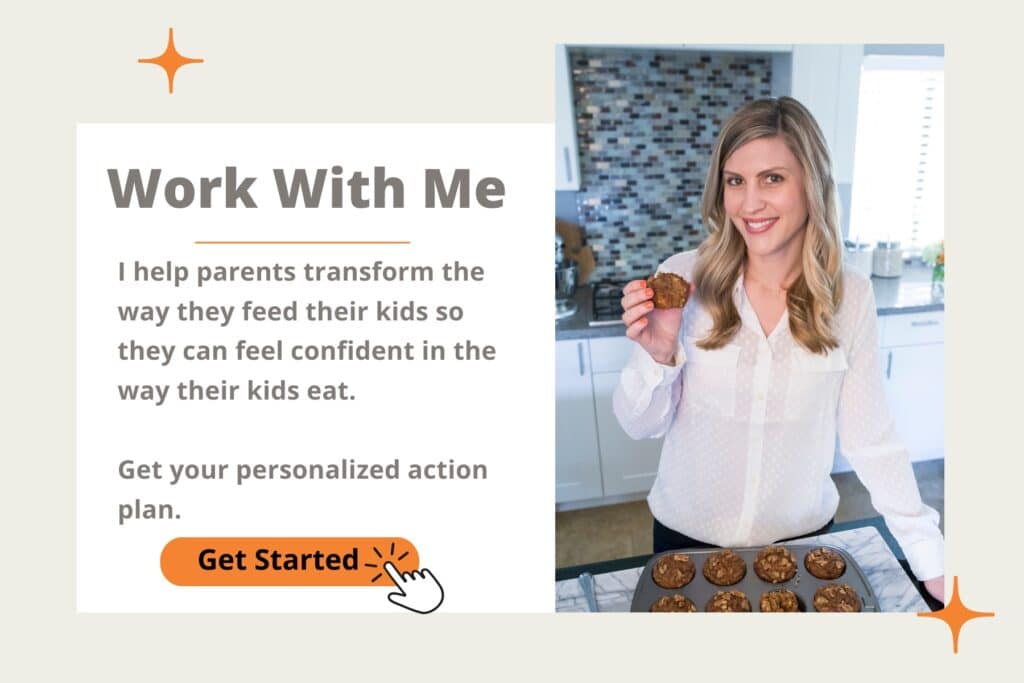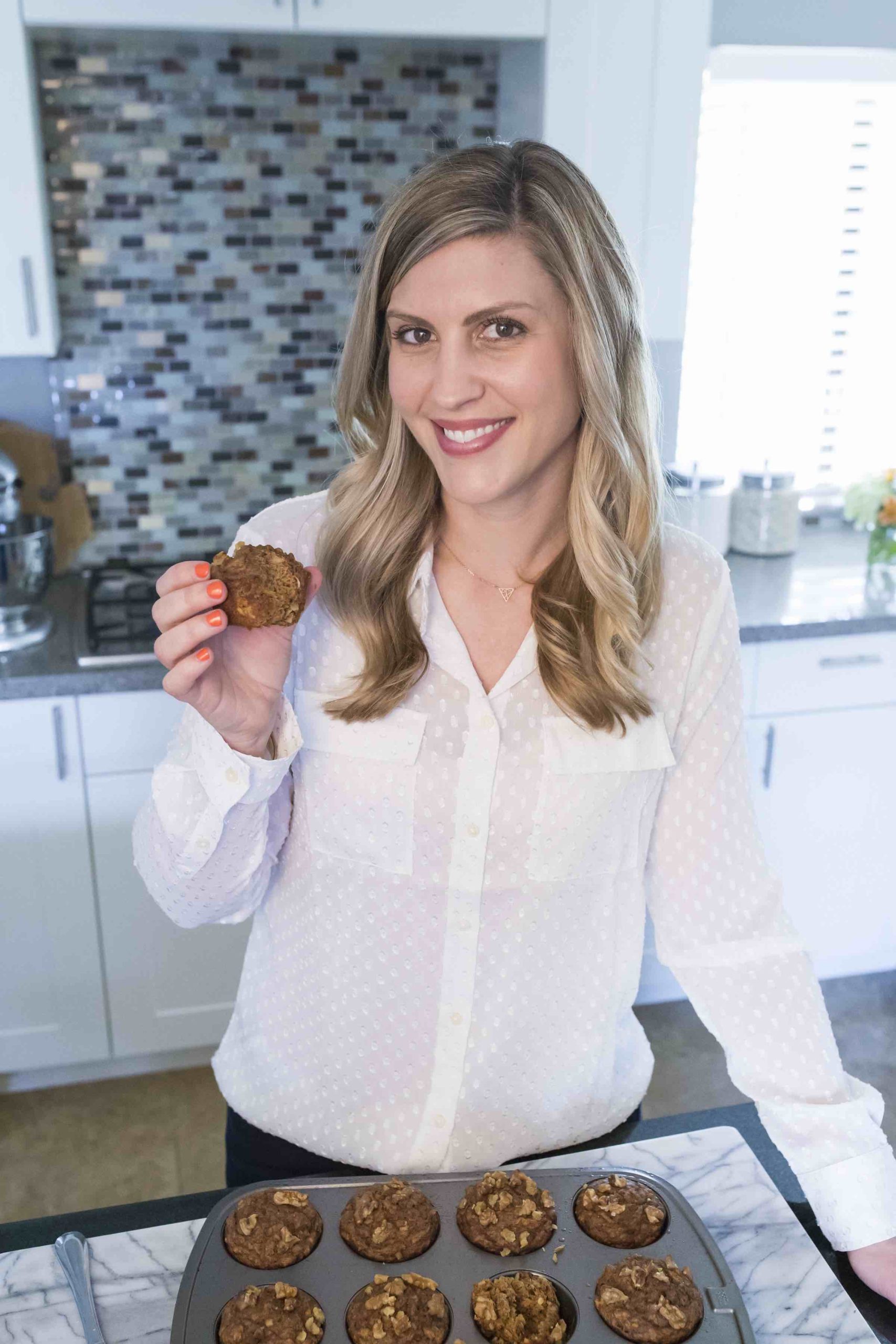If you have kids at home, especially if they tend to be picky eaters, you’ve probably wondered more than once if they were getting enough protein. You might have also wondered what the best protein powder for kids is and if you should start using one. As a mom of two, with one less-than-adventurous eater, I am constantly thinking about ways to get in enough protein at meals.
Inside this article, I will review how much protein your kids need, where they can potentially get it from in their diet, and when they might benefit from protein powder. I’ll also review what to look for when searching for a protein powder for your kids and some ways you can create protein-rich drinks without powder.
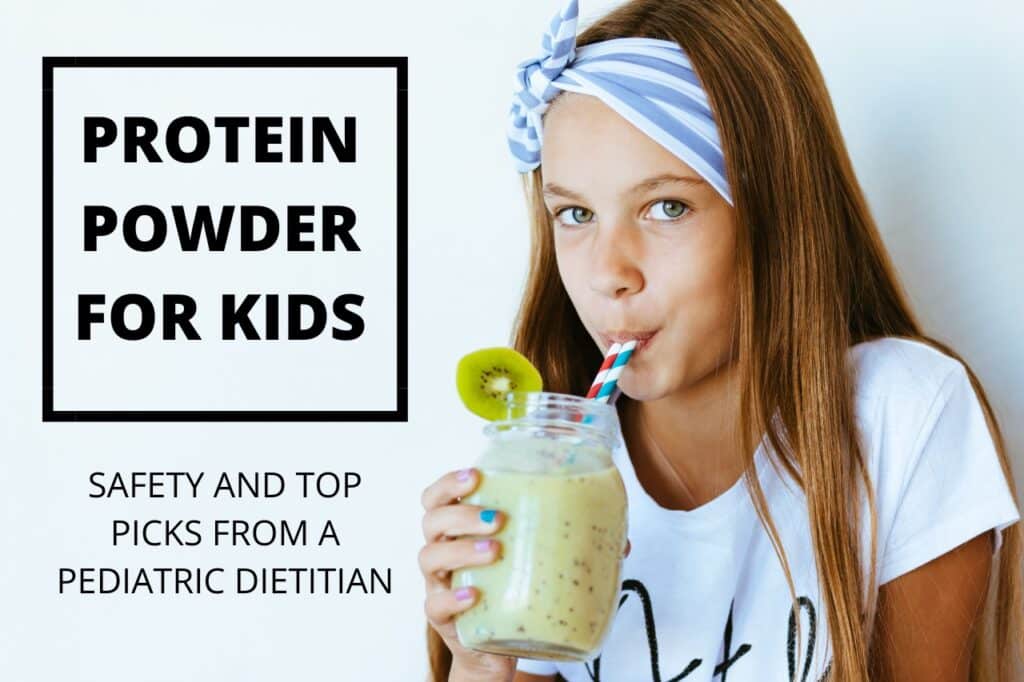
Please note that I am an affiliate for some of the linked products. If you click my affiliate link and make a purchase, I may earn a percentage of the sale at no extra cost to you. As an Amazon Associate, I earn from qualifying purchases.
Table of Contents
What is protein?
Let’s start with a little background on protein because I think this helps you understand what you are looking for. Protein is one of the three macronutrients found within various food groups. Macronutrients include protein, carbohydrates, and fat.
Within the body, proteins play many different roles. They help to build muscle, transport nutrients, support the immune system, and build bones.
In children, adequate protein intake is key for optimal growth and development. Since kids are growing at a rapid rate, we want to make sure they are getting enough protein to support their growth. But, we also want to do this without overloading them on protein, because enough is important but too much isn’t better.
Child protein requirements
As children age their daily protein requirements increase. Up until 14, boys and girls need about the same amount of protein per day, though this will fluctuate based on activity level. After the age of 14 and throughout the teen years and beyond, boys will require more protein for their body’s needs.
Summary of child protein requirements by age
| Age | Daily Protein Requirements |
| 2 – 3 years | 13 grams |
| 4 – 8 years | 19 grams |
| 9 – 13 years | 34 grams |
| 14 -18 years (Girls) | 46 grams |
| 14 – 18 years (Boys) | 52 grams |
Protein supplements for kids
Protein supplements come in various forms. The most popular are protein bars, ready-to-drink protein shakes (liquid), and protein powders.
Most standard protein supplements provide similar nutrients. For kids, they typically contain 6 – 12 grams of protein per serving. Some brands also include added vitamins and minerals.
Protein powders targeted toward adults typically have much higher volumes of protein per serving (20-30 g) so it is important NOT to give children full doses of adult protein powders. Too much protein is not safe for children.
Types of protein powder for kids
There are many different types of protein powders available, the most common are whey, soy, pea, and egg white protein.
When picking a protein powder, there are many different things to consider. Dietary preference and tolerance are the major first choices. If you are a vegan or vegetarian you are probably going to target a plant-based protein powder. If you don’t tolerate lactose or milk proteins you may also be looking for a plant-based powder or an egg white-based powder.
Protein quality is also an important factor when choosing a protein powder. Some protein sources are considered complete proteins (they contain all 9 essential amino acids) and some do not.
Collagen for kids
Collagen protein powder is another popular protein supplement on the market. If you’re taking this as a parent, you might be wondering if it is a good choice for your child.
The proposed benefits of supplementing with collagen powder include improving hair, skin, and nail quality. There are also claims that collagen supplements help to strengthen joints/cartilage and help build muscle. The research around collagen is still new and improving but has provided evidence to support some of these claims.
Collagen powder is made up of 3 amino acids (building blocks of protein). The three amino acids are glycine, hydroxyproline, and proline. Generally speaking, these amino acids are supplied in adequate amounts through a well-balanced diet that includes animal products.
The claims surrounding strengthening joints and helping to build muscle have not yet been proven. This is primarily due to the makeup of collagen powder and the nutrients needed to build muscle and strengthen joints. For these two things to happen the body needs ample amounts of all 20 amino acids whereas collagen powder only provides 3. Children need adequate amounts of protein that include all 20 amino acids. Without these, growth and development may be limited.
Since collagen is not a complete protein, collagen for kids isn’t overly beneficial. If a protein powder is given, a complete protein powder such as whey, egg white, or soy would be the better choice in an appropriate quantity.
Is protein powder safe for kids?
Overall, standard protein powders are typically safe for children when given in appropriate doses. However, there are a few important things to keep in mind.
- Does your child need extra protein? If you can get enough protein from food, this is the best first choice. Food provides many other key nutrients in addition to protein.
- If they do need extra protein, make sure the amount you are giving is appropriate for their age/weight/size. Giving children adult portions of protein powders/drinks is not safe.
- Supplements (protein powder) are not regulated by the FDA, so you want to make sure you trust the brand you are buying (more on that below).
For most children, especially those between 2 and 13 years of age, protein supplements are not needed because their protein needs are fairly low compared to their intake. Even picky eaters can typically get their protein needs met through food alone. However, in picky eaters who do not consume adequate calories, supplements may be beneficial to promote linear growth.
Reasons a child needs more protein
While most kids can get enough protein from their regular diet, there are some circumstances when they may need more protein from other sources, such as a protein supplement.
- Underweight – if your child is underweight for their age, or their growth trends are dropping they might need extra calories (including protein) to help with catch-up growth. This could come from a caloric boost in their food, but also from a calorie/protein supplement combination.
- Vegan diet – vegan diets are often lower in the quantity and quality of protein if not well planned. A well-planned and balanced vegan diet can provide enough protein for children. If your child is vegan and a picky eater, a supplement may be beneficial.
- Vegetarian diet – like vegan diets, vegetarian diets can also be lower in protein if not enough plant-based proteins are consumed. Supplements may help fill in the gaps.
- Picky eater – If your child is a picky eater and missing whole food groups (meat/proteins), their protein intake might not be enough. A protein supplement might help bridge the gap while working on improving their food acceptance.
- Activity level – If you have an extremely active child playing competitive sports, their protein needs will likely be higher. If the volume of food they can consume doesn’t support the increased need, a protein drink might help.
Kids protein powder: what to look for
Nutrients
If the main reason for purchasing a protein supplement is simply to increase the amount of protein in your child’s diet, the bulk of the calories should be coming from protein (no added sugar or fat). Protein is 4 calories per gram so if the powder you buy has 10 grams of protein then there will be at least 40 calories per serving. Any extra calories come from added sugar, fat, etc.
If the total calories greatly exceed the calories from the protein this might not be the best protein powder choice (unless increasing calories is the goal.)
Ingredients
When selecting a protein supplement it is important to glance through the ingredient list. Ingredients are listed by weight, so the order in which you see ingredients listed is what is highest in the product. With protein supplements you always want the first ingredient to be a protein source unless it is a ready-to-drink (liquid) item then water should be the first ingredient.
If a sugar source is the first ingredient in the product, that should be a red flag.
Protein content
Children do not require large amounts of protein. So if you are buying a protein supplement, it’s best to buy one that will help them meet their needs but not significantly exceed them. Many protein supplements have large amounts of protein per serving which could easily put your child significantly over their daily requirement.
For example, a protein drink that contains 12 g of protein would meet almost 100% of the protein needs of a child between 2-3 years of age. Choosing a supplement with a lower volume of protein would be more appropriate for this age. It is not safe to give full servings of adult protein supplements to children (especially children under 14.)
Be mindful of how much protein your child needs and get a good estimate of how much protein they are getting from their diet before adding in a protein supplement. I generally recommend sticking to about ¼-½ (max) of their daily protein needs in a serving of a supplement they are getting. Be very cautious when sharing an adult protein powder with your child.
Vitamins and Minerals
Many supplement drinks (ready-to-serve/liquid protein drinks) have added vitamins and minerals. This isn’t necessarily a bad thing, however, if your child is consuming multiple supplement drinks plus taking a multivitamin or other vitamin sources, together they could exceed their daily recommended levels. Be mindful of how many multivitamin sources they are getting each day.
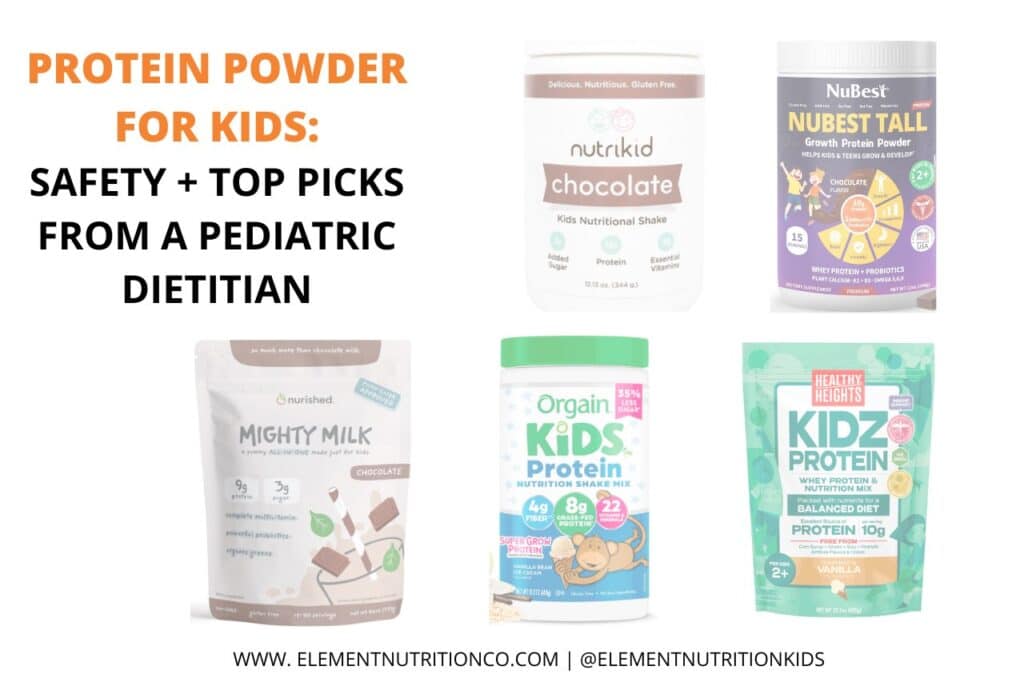
Safe protein powder for kids
If you need a protein supplement, you might wonder how to pick the right one for your child. There are a TON of protein powders on the market and picking the right one can feel daunting.
Generally speaking, most protein powders are “safe” for kids, however, it is important to know that there are no strict regulations over protein supplements. The Food and Drug Administration (FDA), which oversees the safety of our food, has little involvement with regulating protein supplements.
The FDA is only responsible for inspecting the supplement manufacturing facility and ensuring that the product labels are accurate. The FDA will take more action only if a serious event occurs from consuming a supplement.
To help ensure that a product is safe it is left up to the supplement company to ensure that they are following protocols to ensure they are meeting safety standards. For any supplement you buy (including protein powders), I recommend looking for products that have the Good Manufacturing Practice Label (GMP). It is also a bonus if they’ve been tested by a reputable third party (such as NSF).

Kid-safe protein powder
While it is always best to try and get enough protein from food first, there may be times when a protein powder is helpful. These are a few of the protein powders I found that have a good ratio of ingredients (calories, protein, added sugar) and have the GMP label (per their website.) *Please note, most of these protein powders contain whey protein.
- Nutrikid (GMP Certified)
- NuBest Tall (GMP Certified)
- Mighty Milk (GMP Certified
- Orgain Kids (GMP Certified) (*They also make a plant-based version in their liquid shake)
- Healthy Heights Kidz Protein (GMP Certified) (*They also make a vegan version)
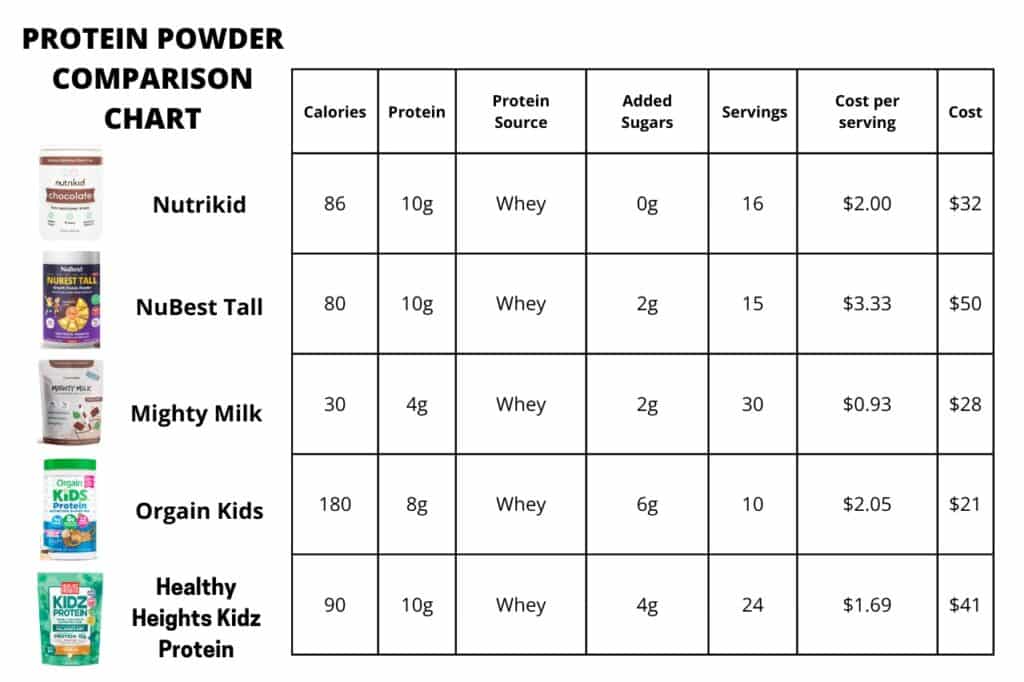
If you’re looking to boost your child’s protein intake and you don’t want to use a protein powder, these are a few pre-made drinks you could consider. *Please note, that some contain more calories, protein, and sugar than others, so be mindful of your goal when purchasing.
- Horizon Organic Shelf Stable Milk (Milk) (8 oz, 150 kcal, 8 g protein, 0 g added sugar)
- Fair Life Core Power (Milk) (14 oz., 170 kcal, 26 g protein, 0 g added sugar)
- Ripple Plant Based Protein Shake (Pea Protein) (12 oz, 200 kcal, 20 g protein, 9 g added sugar)
- Kate Farms Pediatric Nutrition Shake (Pea Protein) (8.5 oz, 250 kcal, 8 g protein, 8 g sugar)
- Orgain Kids Plant Based Shake (Pea/Chia Blend) (8 oz, 200 kcal, 8 g protein, 9 g sugar)
Risks associated with too many protein supplements
If you’re giving your kids a protein supplement in drink form or powder form there are a few important things to keep in mind.
- Unintended weight gain: some protein supplements contain unnecessary amounts of calories. These excess calories can easily put a child over their caloric limit for the day in which the excess calories could be stored as fat. While this might be ok for underweight children (under the supervision of a pediatric dietitian) it may be a concern for children who are at a healthy weight and just need to increase their protein intake.
- Increased hunger: while the point of the protein supplements is to help meet their protein needs, they can contribute to children exceeding their weight targets. Besides the excess calories, protein supplements (consumed in a liquid form) can be less satiating than regular food. This can result in the child becoming hungry soon after consuming the protein drink, leading to overeating.
- Disordered eating behaviors: in the early stages of life, children are learning different eating behaviors. If they are consuming most of their protein in drink form, this may negatively impact eating patterns and skills later in life.
- Nutrient deficiencies: even though the idea of supplementation is to increase a child’s nutrition status it can also be the cause of nutrient deficiency. If the child frequently consumes protein supplements, especially those not fortified with key nutrients they need for growth, this may leave little room for nutrients from other whole food sources.
- Kidney damage: the kidneys act as a filtration device for our bodies. One of its roles is to filter protein. With regular protein intake, the kidneys will have no problem with filtration. However, with excess protein intake, there can be an issue. Excess protein will place added pressure on the kidneys. This added pressure over a constant period can result in kidney damage.
- Dehydration: the process for your kidneys to filter out excess protein requires additional water. If you are not drinking enough water to support this process then you can become dehydrated.
Do kids need protein supplements?
If you’ve made it this far, you can probably see that for the majority of children, protein supplements are unnecessary. From the ages of 2 – 14, the daily protein requirement is quite low. If you have a picky eater, focusing on high-protein foods for your picky eater can help.
If finding enough protein-rich foods that your kids like is a challenge, I have a guide that will help! You can download it below 🙂
Protein shakes for teens
Once kids hit 13 years their protein intakes start to increase a bit. For most teens, they can still get more than enough protein from the foods they eat. However, skipping meals becomes more common in the teenage years, especially when they are at school.
When I think back to my teen years, I cringe a little thinking about how poor my breakfast and lunch choices were. Sleeping in and getting ready didn’t allow for much time to eat a solid breakfast and at lunch, I much preferred to just hang with friends than eat a solid meal.
If you have a teen who often skips meals, a protein shake might be a good meal alternative for them. Teens between 14-18 need anywhere from ~46-52 grams of protein per day, more if they have high activity from sports. When looking for a protein drink for teens I usually recommend sticking to 15-18 g protein/serving (about ⅓ their daily need).
If you’re looking for convenience, a pre-made protein drink (that comes in a container) might be the best choice. They can grab these and go on their way to school or throw them in their backpack for a nutrition break or lunch.
These are a few of my favorite, convenient on-the-go options to help teens get more protein. Depending on their need, they may only need 1/2 serving at a time.
- Horizon Organic Shelf Stable Milk Container (Milk) (8 oz, 150 kcal, 8 g protein, 0 g added sugar)
- Fair Life Core Power (Milk Based) (14 oz., 170 kcal, 26 g protein, 0 g added sugar)
- Ripple Plant Based Protein Shake (Pea Protein) (12 oz, 200 kcal, 20 g protein, 9 g added sugar)
- Premier Protein (Milk Based) (11 oz., 160 kcal, 30 g protein, 0g added sugar)
You could also make a homemade protein drink at home if you have more time. (Recipe below for some of my favorite easy homemade protein drinks). The recipes below are great for younger kids, double the portion for teens who need more calories/protein.
Protein powder alternatives
While protein supplements are convenient and beneficial in some cases, they are not necessary for most kids and teens. If you’re looking to get an extra protein boost for your kids you can easily make your protein drink at home for a fraction of the cost. My favorite protein powder alternatives are drinks that contain:
- Milk/Milk alternatives (like soy, pea, or a plant-based blend that contains ~7-8 g protein/cup)
- Peanut butter or Peanut butter powder
- Greek yogurt/plain yogurt or alternatives with similar protein (these are best yogurts for babies/kids/teens)
- Seeds (chia and hemp) mix with the above
Below are two of my favorite homemade protein drink recipes for toddlers/kids/teens. I’ve used these for years for my home health and private practice clients. My kids love option #1, because, chocolate! Adjust the portion size based on their protein need (double for older kids/teens).
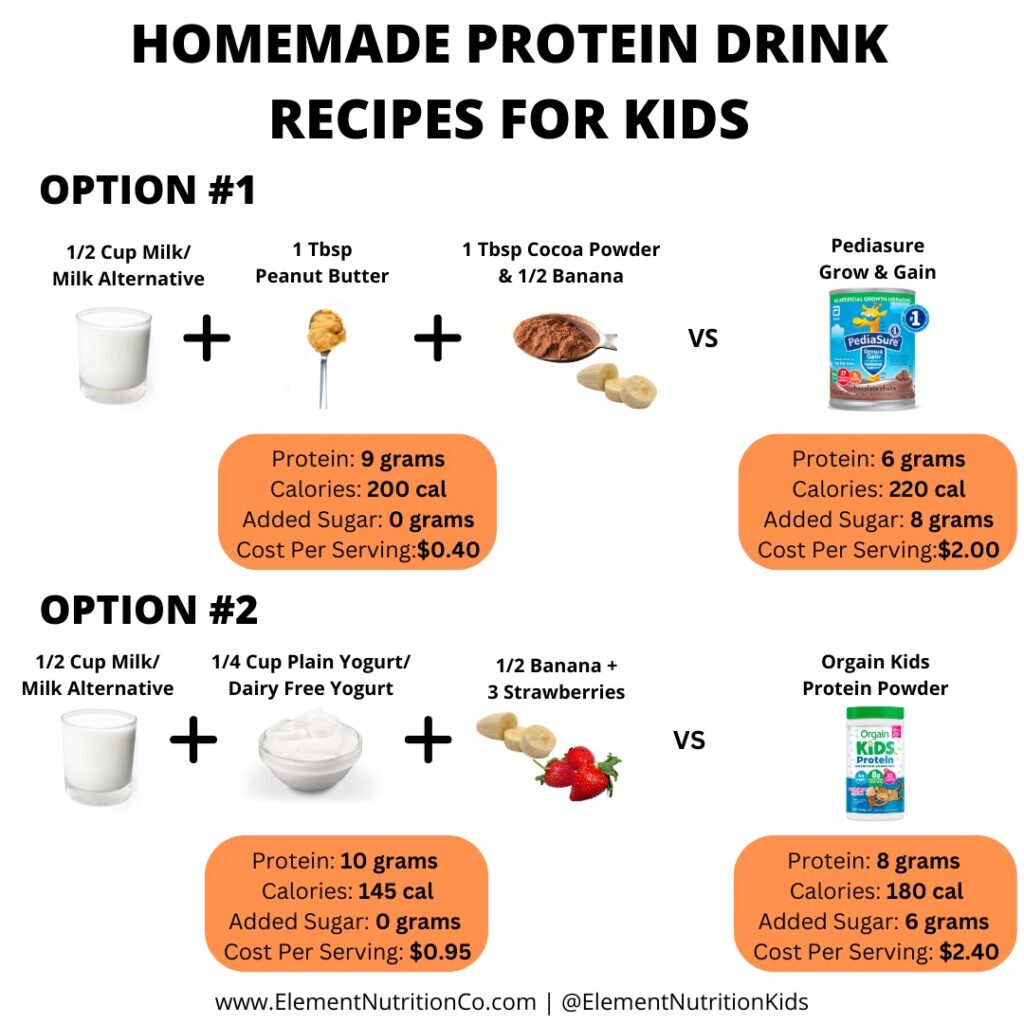
Chocolate Peanut Butter Shake
- ½ Cup of non-fat milk, soy or pea milk
- 1 Tbsp Peanut Butter
- 1 Tbsp Cocoa Powder
- 1/2 Banana (I like them frozen)
- Place all ingredients in a blender and blend until desired consistency
- Can add water for a thinner consistency
Strawberry Banana Shake
- ½ Cup of non-fat milk, soy or pea milk
- ¼ Cup of non-fat Greek yogurt or alternative
- ½ medium banana (I like frozen)
- 3 medium strawberries
- Place all ingredients in a blender and blend until desired consistency
- Can add water for a thinner consistency
Summary
Protein is essential to the growth and development of kids. Throughout childhood protein requirements will continue to increase. During these times some kids may need additional protein to help with certain needs.
Children who may need extra protein include picky eaters, vegans or vegetarians, underweight kids who need help with catch-up growth, and highly athletic kids. If your child is not in one of these categories, they can probably meet their protein needs with the foods they eat.
If you feel your child is lacking protein, picking an appropriate supplement is key. Keep in mind the safety of the product by finding one made by a company that follows good manufacturing practices (GMP.) Watch how much protein you are giving your child and avoid adult portions of protein powders for kids.
When possible, to save money, making your protein drink at home is beneficial. This will also help you reduce the added sugar and “extras” that your child might not need.
If you struggle with a picky eater or fear your child isn’t getting enough protein and would like some extra support from a pediatric dietitian, I can help. You can schedule a 1:1 consultation with me to review your child’s individual needs.
*Thank you Sean Cormier, MS, Dietetic Intern for his contributions to the research and writing of this article.
